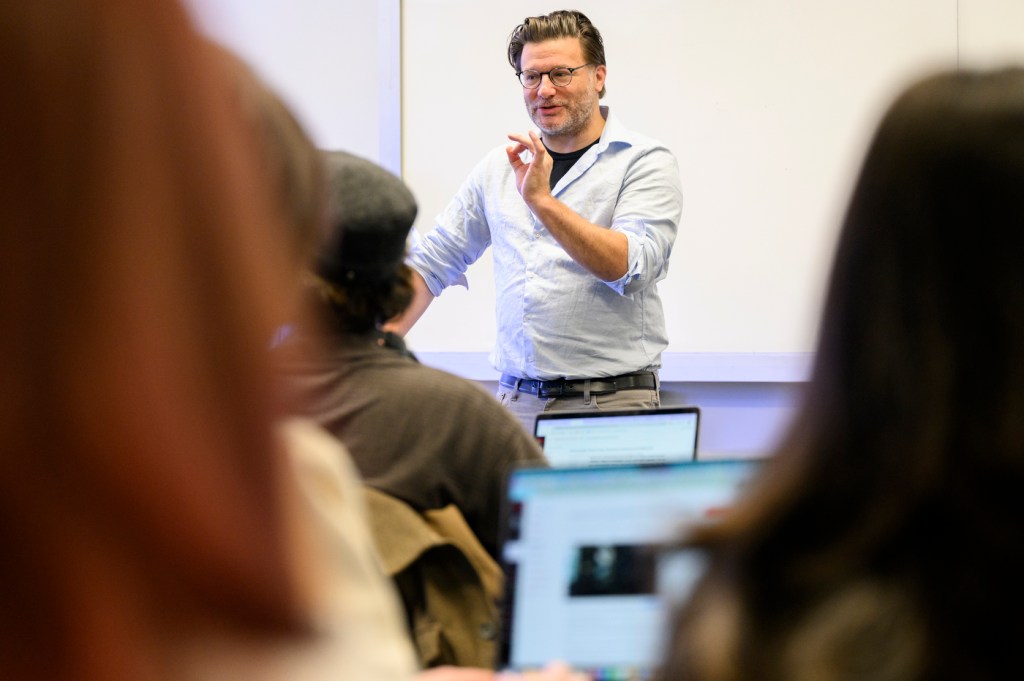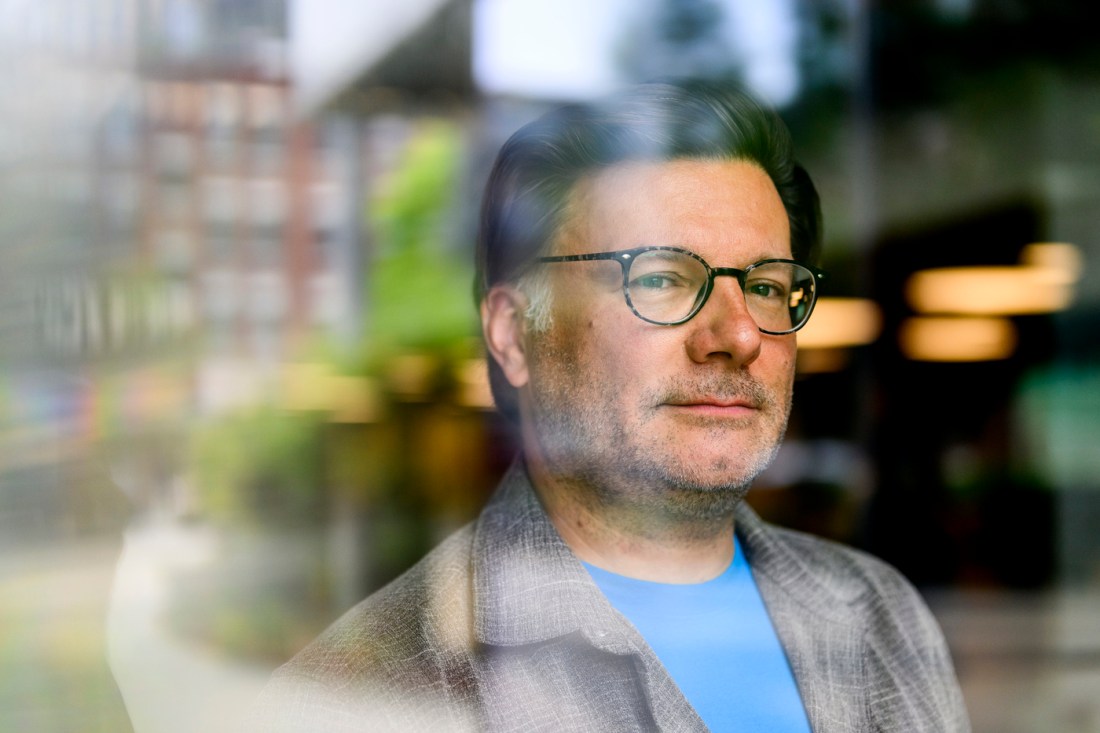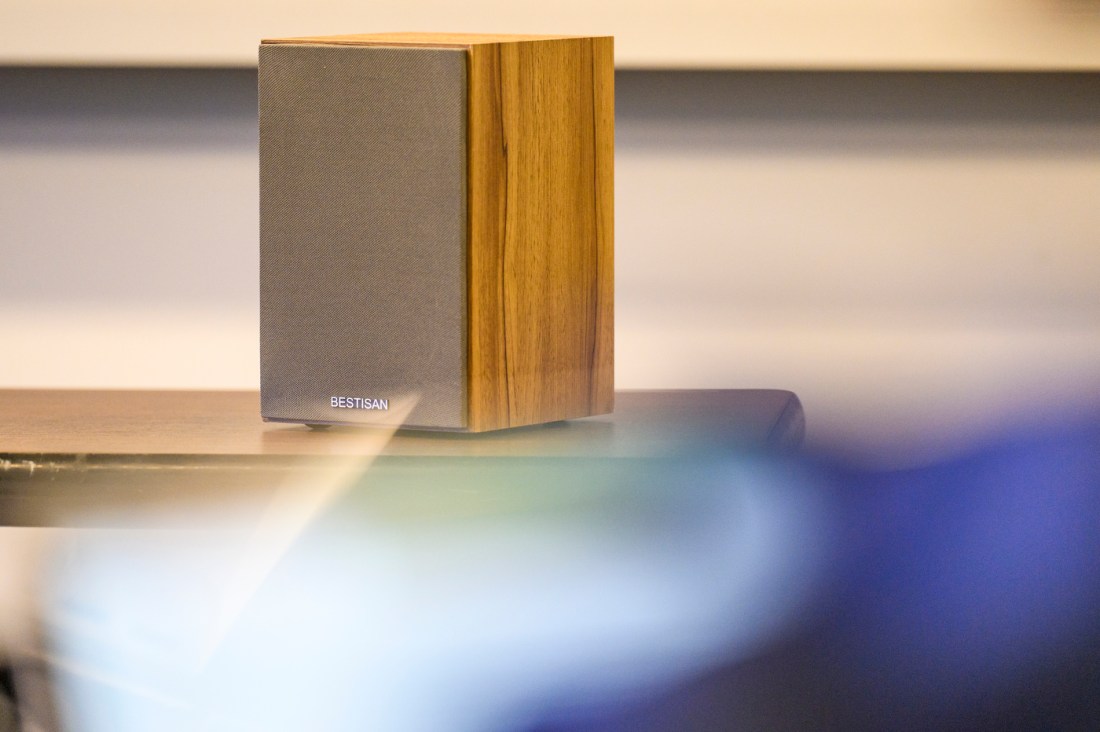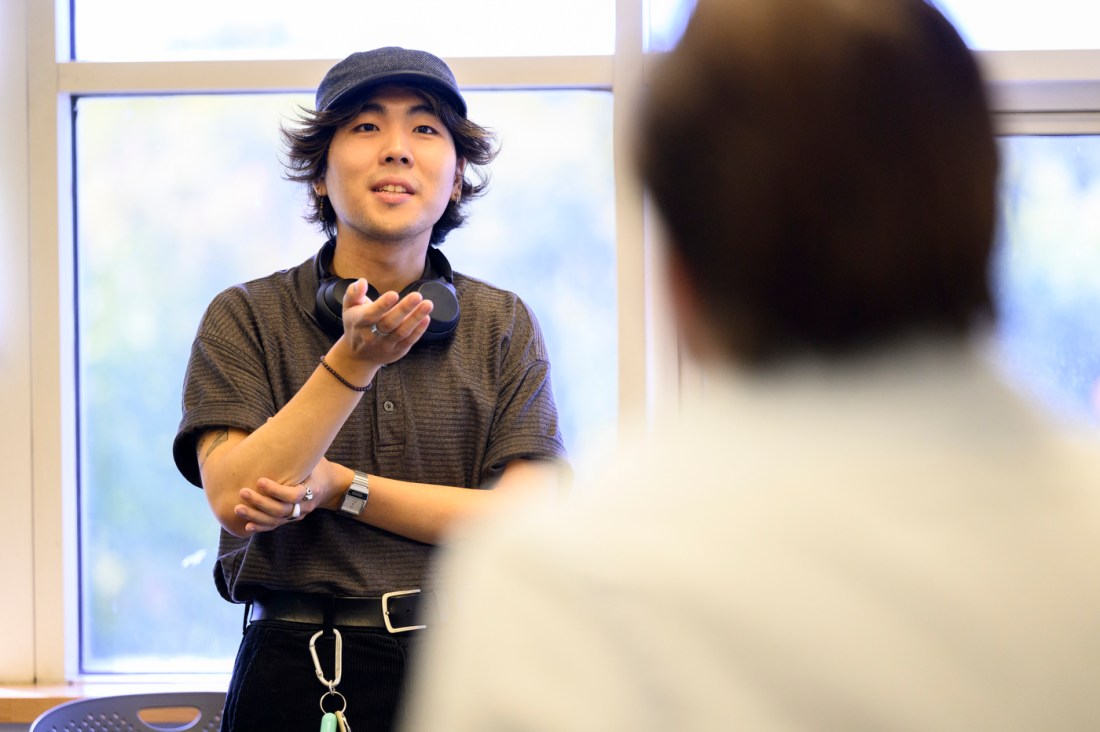Northeastern students learn how to analyze art and literature. What about sound?
In MSCR 2450: Sound Cultures, Seth Mulliken’s Media Studies students learn to think critically about the noises all around them, from music to train horns and police sirens.

Seth Mulliken starts his Sound Cultures class by asking the assembled students in Ryder 435 to huddle together. This way, they can all be closer to the speakers, which are placed at intervals all around the room and dropping down from the ceiling.
“Remember precedence,” the Northeastern University associate teaching professor tells them. “Precedence is the phenomenon in which closeness to the speakers changes how we perceive right and left.” He turns to the students. “OK, who is interested in volunteering?”
Charles Moon walks to the front of the room. The students have been asked to choose a piece of music and discuss how sound technologies are used within it, and to what effect. Moon has picked “Born Slippy .NUXX,” a techno track by the British group Underworld made famous in the 1996 movie “Trainspotting.” Moon zeros in on a section of the song that transitions from synthesizers to full drums, describing how the shift ushers in a claustrophobic sense of chaos.
“It transitions away from the work of calming … by creating this almost chaotic chaos, disorderly sounds of drums and rhythms. Where beforehand, the space is way more open,” Moon says.

Next, second-year media studies major Helena (Hedan) Chen unpacks “I’m O.K.” by David Tao. An alt-rock-style lament sung in Mandarin, the song incorporates a recorded voicemail message, with Tao barely audible in response.
“It’s trying to induce a particular reaction in the audience,” Mulliken points out. “You have to try really hard to listen, to figure out what he’s saying. We could talk about that as both a reduced and semantic listening mode, because you’re struggling to figure out what the literal words are.”
MSCR 2450: Sound Cultures is a new course in Northeastern University’s College of Art Media and Design (CAMD) for fall 2024. In other assignments, students will unpack film and TV sound clips, environmental noises (train horns, sirens) and “technologies that make sound,” like headphones and baby monitors. Together with class readings and lectures, the goal is to give students a toolkit to think critically about sound in the same way they might a literary text or a painting.
“So much media involves sound in some way, but we have a lack of a critical language to approach it,” Mulliken says. “We have many ways we analyze the visual elements of cinema, television, social media, but the same attention is not given to sound. That’s why we need to talk about this — we’re neglecting a massive part of our experiences.”



Mulliken has taught at Northeastern for 11 years. He has a master’s of fine arts degree in filmmaking and a PhD in media studies, and his academic research is at the intersection of sound studies and critical race theory. “The question of power is always present, even when we’re analyzing a media text,” he says. “We’re always [asking]: how does this privilege a particular way of thinking or hearing?”
“I’ve wanted to teach this class for a while,” he continues. “[We address] questions of culture, technology and power, and how that works through sound — and the technological media used to create it.”
An intermediate-level course, Sound Cultures is primarily geared at media studies majors, though the inaugural group has music industry students too. The syllabus is divided into three units: The first focuses on technical vocabulary (“mobile heterotopia;” visualized vs. acousmatic sound); the second on sound technologies (amplification, recording, etc.). The third asks the students to take that technical foundation and apply it to the cultural meanings and practices of sound.
Featured Posts
In class, a lot of time is devoted to close listening that highlights certain concepts. In a recent session, the group listened to “What’s He Building In There,” by Tom Waits, which Mulliken describes as less a song and more of a spoken word piece with accompanying sounds.
“It really helped us think about the ways that sounds are placed into a spatial relationship to our ears,” Mulliken says. “By paying attention to those, we can say, ‘it’s supposed to be unsettling and give us a sense that we can’t quite understand where we are.’ It’s purposefully disruptive to our sense of spatial reality.”
For the unit on sound technologies, the class will go on walks around the Boston campus, which, with its pedestrian-friendly green space surrounded by urban bustle, presents a rich case study.
“It’s wonderful that we have subway and commuter rail lines by campus,” Mulliken says.
“When the trains go by, what are the ways we’re asked to listen to that? Are we meant to hear it as disruptive, or are we meant to hear it as a kind of emblematic of the wonderful diversity and urban-ness of our campus?”
Such questions offer a useful segue into the cultural practices of sound — a topic that touches on questions about their implications for different groups. One of the readings for Sound Cultures, for instance, is on car stereos and racial stereotyping.
“A lot of regulations around loud car stereos are stated in very general terms, but in practice in many cities, they’re a way to criminalize young Black and brown folks playing music in their cars,” Mulliken says. “The music is deemed threatening when played loudly from a car tends to be in proximity with folks of color, folks of African descent, Latinx folks. I’m a white guy; if I roll down the street with some John Philip Sousa blaring, I may get a ticket. But I’m not really the target of that.”
To Mulliken, the ability to think deeply about such issues is a useful skill beyond the obvious fields of study. “What I’m hoping is that whatever disciplinary interest they have, students will take away a critical perspective on sound — whether that ends up being media studies or public relations or advertising,” he says.











